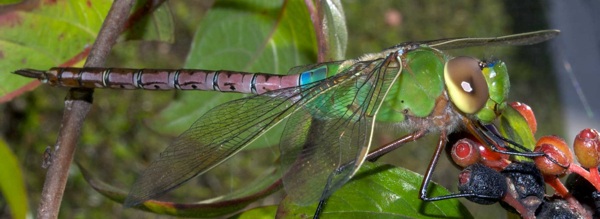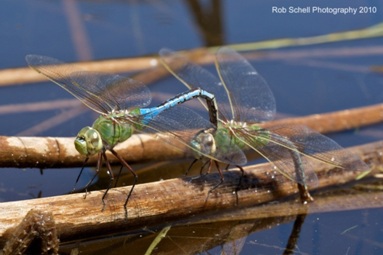
Habitat
 Anax
junius is found around any freshwater habitat. They
inhabit a variety of lakes, streams, swamps, marshes, and ponds
(Paulson 2009).
Although Anax junius is most common in these moist
areas, it also inhabits a variety of non-wetland areas, mostly
due to their swarming migratory seasons (Paulson
2009). Because of their breeding strategy, these mature
adult dragonflies move north in spring where they breed, and
their larvae will emerge later that summer, before migrating back
south in the fall (Paulson 2009).
Anax
junius is found around any freshwater habitat. They
inhabit a variety of lakes, streams, swamps, marshes, and ponds
(Paulson 2009).
Although Anax junius is most common in these moist
areas, it also inhabits a variety of non-wetland areas, mostly
due to their swarming migratory seasons (Paulson
2009). Because of their breeding strategy, these mature
adult dragonflies move north in spring where they breed, and
their larvae will emerge later that summer, before migrating back
south in the fall (Paulson 2009).
Common Green Darners are mainly found in these
types of habitats due to their diet and reproduction.
Male members
of the Order Odonata have b een found to be territorial and it is not
uncommon for them to chase away other males of the same species (Gordh
and Headrick 2001). Anax junius are swift fliers and
may patrol and roam large areas in search of prey (Gordh
and Headrick 2001). When looking for Anax junius, it
is useful to look in habitats that lack fish, as this is what they
prefer (Paulson 2009).
The geographic region where Anax junius can be found in the
United States is from Maine all the way west to California. They
occur in more aquatic type habitats as far north as the U.P. in
summer, to Florida throughout the winter (Gordh
and Headrick 2001).
een found to be territorial and it is not
uncommon for them to chase away other males of the same species (Gordh
and Headrick 2001). Anax junius are swift fliers and
may patrol and roam large areas in search of prey (Gordh
and Headrick 2001). When looking for Anax junius, it
is useful to look in habitats that lack fish, as this is what they
prefer (Paulson 2009).
The geographic region where Anax junius can be found in the
United States is from Maine all the way west to California. They
occur in more aquatic type habitats as far north as the U.P. in
summer, to Florida throughout the winter (Gordh
and Headrick 2001).
For more information about the habitat and geography of Anax junius, please visit the IUCN Red List for Threaten Species.
To see a map of the abundance of Anax junius throughout the United States, please visit DiscoverLife.org.
Next explore the
Nutrition of Anax
junius
Return to the Homepage